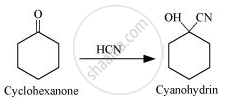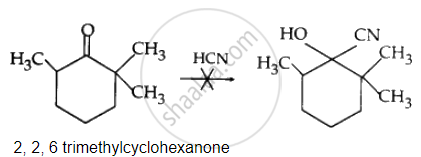Advertisements
Advertisements
Question
Give plausible explanation for the following:
Cyclohexanone forms cyanohydrin in good yield but 2, 2, 6 trimethylcyclohexanone does not.
Solution


Due to the presence of three methyl groups at α-places, nucleophilic attack of CN– ions does not occur. This steric hindrance is absent in cyclohexane. Hence, nucleophilic attack of CN– ions occurs quickly. Hence, cyclohexanone cyanohydrin is obtained in good yield.
APPEARS IN
RELATED QUESTIONS
Acetaldehyde, when treated with which among the following reagents does NOT undergo addition reaction?
(A) Ammonia
(B) Hydroxylamine
(C) Ammoniacal silver nitrate
(D) Semicarbazide
Draw the structure of the semicarbazone of ethanal.
Write the products formed when CH3CHO reacts with the following reagents : HCN
Predict the product of the following reaction:

Predict the product of the following reaction:
\[\begin{array}{cc}
\phantom{..............}\ce{O}\\
\phantom{..............}||\\
\ce{R - CH = CH - CHO + NH2 - C - NH - NH2 ->[H+]}\end{array}\]
What is meant by the following term? Give an example of the reaction in the following case.
Hemiacetal
What is meant by the following term? Give an example of the reaction in the following case.
2, 4-DNP-derivative
Predict the products formed when cyclohexanecarbaldehyde reacts with the following reagents.
Excess ethanol and acid
Write a test to differentiate between pentan-2-one and pentan-3-one.
Which one of the following gives only one monochloro derivative?
Which of the following has the most acidic hydrogen?
Acetaldehyde and acetone differ in their reaction with
Which among the following is most reactive to give nucleophilic addition?
Draw structures of the given derivatives.
The ethylene ketal of hexan-3-one
Why dissociation of HCN is suppressed by the addition of HCL?
Draw structure of the following derivative.
The ethylene ketal of hexan-3-one
The product of the following reaction is
\[\begin{array}{cc}
\ce{O}\phantom{.........}\\
||\phantom{.........}\\
\ce{C2H5 - C - CH3 ->[H2/Ni][\Delta] \phantom{..}?}\end{array}\]
Draw the structure of the following derivative.
Acetaldehydedimethylacetal
